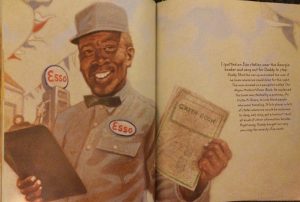Author: Calvin Alexander Ramsey
Illustrator: Floyd Cooper
Publisher and Year: Carolrhoda Books, 2010
Number of Pages: 29 Pages
Genre: Historical Fiction
This historical fiction tells of Ruth and her family’s drive to Alabama to visit Ruth’s grandmother in 1952. Ruth’s family originates from Chicago and travels to Alabama with Daddy’s new Sea Mist Green Buick (Ramsey, 2010). On their travels, Ruth and her family encounter segregation and learn of the Negro Motorist Green Book, a pamphlet that helped African Americans travel and listed places they were allowed to go (hotels, gas stations, and restaurants). Though the story of Ruth is fictional, the book highlights the real historical event of the struggle of travel for African Americans ten years before the Civil Rights Movement.
This book serves as a window because it gives the reader (at a young age) an insight into the struggles of African Americans and historical information about Jim Crow Laws. By serving as a mirror, it reminds the audience that segregation is not good and regardless of skin color, a person is a living human being first. In addition, it serves as a door because the author presents this information to the reader in the hopes that the reader is an advocate against unequal treatment of people. This story clearly represents the African American cultures and their struggles to survive within the confines of Jim Crow Laws in the 1950s. During this time, African Americans were not allowed in certain places in the South solely because of their skin color. As terrible as this was, this book does highlight on a very positive note for African American culture: the sense of community and friendship. Through the “green book,” African Americans met with others in various places on the road and were able to share stories with each other. As Ruth shared when her family stayed in an inn one night, “It felt like I was part of one big family” (Ramsey, 2010). Through the obstacles of segregation and unequal treatment, African Americans were able to come together as one to enjoy times to share their experiences and feel like a family outside of the struggles on the road.
Perceptually, the images are very large showing that the images express the emotions of the text. At the same time, the text is easy to find, meaning that the words are just as important as well. In addition, last page of the book is historical story of the green book to allow the reader to learn the historical facts of the event. The pictures in the story have blurry background showing that the green book is an event in the past. At the same time, the facial expressions of the characters are detailed so that the reader understands the emotional hardships of segregation among group. In addition, the dialect of South is used to be historically in line with the historical event of the green book. Through this book, the African Americans culture honored and remembered for their struggles with segregation. In addition, the reader learns of a real historical event that goes unnoticed. Most important, the biggest lesson of this book is skin color does not make one superior.







 This story is about a young girl and her love for paletas and her barrio. A paleta is an icy fruit popsicle, and a barrio is a neighborhood. On each page she talks about all the roles that the paleta plays in her neighborhood.
This story is about a young girl and her love for paletas and her barrio. A paleta is an icy fruit popsicle, and a barrio is a neighborhood. On each page she talks about all the roles that the paleta plays in her neighborhood.




 One Fine Day is a Caldecott Medal winner. It is a story about a little fox that gets is tail cut off by an old woman for drinking her milk. The only way he is able to get his tail back is if he brings the old woman more milk.
One Fine Day is a Caldecott Medal winner. It is a story about a little fox that gets is tail cut off by an old woman for drinking her milk. The only way he is able to get his tail back is if he brings the old woman more milk.
 her is a story about a woman named Miss Sally Ann Thunder Ann Whirlwind and her adventure with Fireeyes the panther. The story starts off talking about all the things she does which is spin yarn, make clothes, and milk cows. On day she goes into the forest and runs into the panther, they fight for days then they become good friends. The panther ends up living with Miss Sally Ann in her house and they cook, clean, play and sing together.
her is a story about a woman named Miss Sally Ann Thunder Ann Whirlwind and her adventure with Fireeyes the panther. The story starts off talking about all the things she does which is spin yarn, make clothes, and milk cows. On day she goes into the forest and runs into the panther, they fight for days then they become good friends. The panther ends up living with Miss Sally Ann in her house and they cook, clean, play and sing together.


 Analysis:
Analysis: 